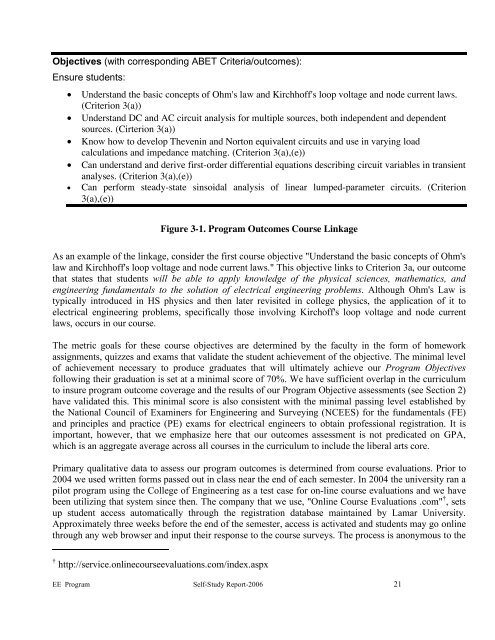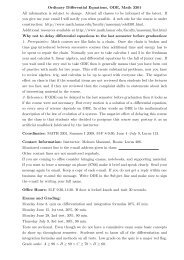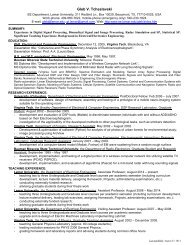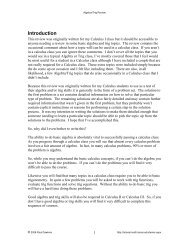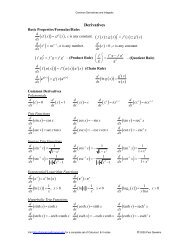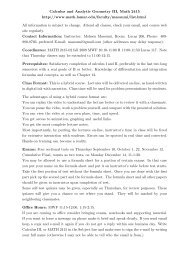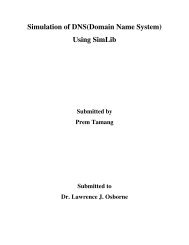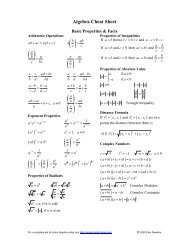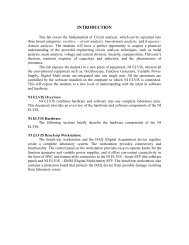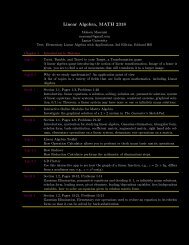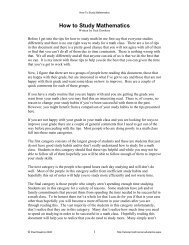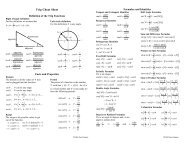program self-study report - Lamar University Electrical Engineering
program self-study report - Lamar University Electrical Engineering
program self-study report - Lamar University Electrical Engineering
Create successful ePaper yourself
Turn your PDF publications into a flip-book with our unique Google optimized e-Paper software.
Objectives (with corresponding ABET Criteria/outcomes):Ensure students:• Understand the basic concepts of Ohm's law and Kirchhoff's loop voltage and node current laws.(Criterion 3(a))• Understand DC and AC circuit analysis for multiple sources, both independent and dependentsources. (Cirterion 3(a))• Know how to develop Thevenin and Norton equivalent circuits and use in varying loadcalculations and impedance matching. (Criterion 3(a),(e))• Can understand and derive first-order differential equations describing circuit variables in transientanalyses. (Criterion 3(a),(e))• Can perform steady-state sinsoidal analysis of linear lumped-parameter circuits. (Criterion3(a),(e))Figure 3-1. Program Outcomes Course LinkageAs an example of the linkage, consider the first course objective "Understand the basic concepts of Ohm'slaw and Kirchhoff's loop voltage and node current laws." This objective links to Criterion 3a, our outcomethat states that students will be able to apply knowledge of the physical sciences, mathematics, andengineering fundamentals to the solution of electrical engineering problems. Although Ohm's Law istypically introduced in HS physics and then later revisited in college physics, the application of it toelectrical engineering problems, specifically those involving Kirchoff's loop voltage and node currentlaws, occurs in our course.The metric goals for these course objectives are determined by the faculty in the form of homeworkassignments, quizzes and exams that validate the student achievement of the objective. The minimal levelof achievement necessary to produce graduates that will ultimately achieve our Program Objectivesfollowing their graduation is set at a minimal score of 70%. We have sufficient overlap in the curriculumto insure <strong>program</strong> outcome coverage and the results of our Program Objective assessments (see Section 2)have validated this. This minimal score is also consistent with the minimal passing level established bythe National Council of Examiners for <strong>Engineering</strong> and Surveying (NCEES) for the fundamentals (FE)and principles and practice (PE) exams for electrical engineers to obtain professional registration. It isimportant, however, that we emphasize here that our outcomes assessment is not predicated on GPA,which is an aggregate average across all courses in the curriculum to include the liberal arts core.Primary qualitative data to assess our <strong>program</strong> outcomes is determined from course evaluations. Prior to2004 we used written forms passed out in class near the end of each semester. In 2004 the university ran apilot <strong>program</strong> using the College of <strong>Engineering</strong> as a test case for on-line course evaluations and we havebeen utilizing that system since then. The company that we use, "Online Course Evaluations .com" † , setsup student access automatically through the registration database maintained by <strong>Lamar</strong> <strong>University</strong>.Approximately three weeks before the end of the semester, access is activated and students may go onlinethrough any web browser and input their response to the course surveys. The process is anonymous to the† http://service.onlinecourseevaluations.com/index.aspxEE Program Self-Study Report-2006 21


